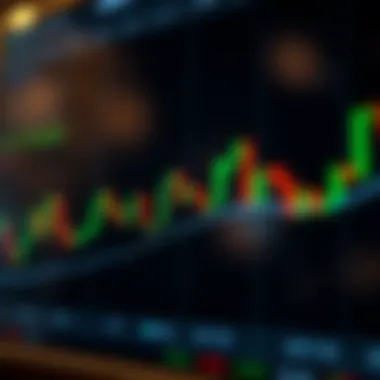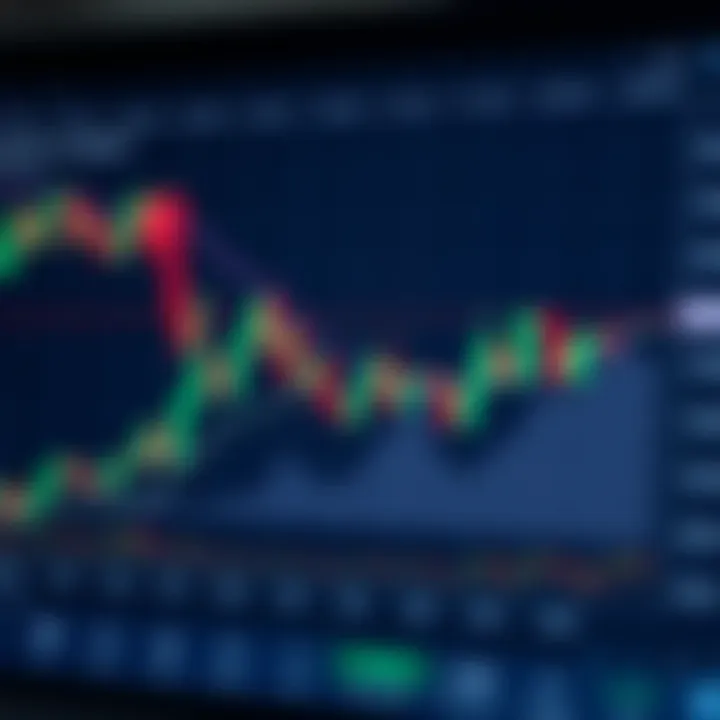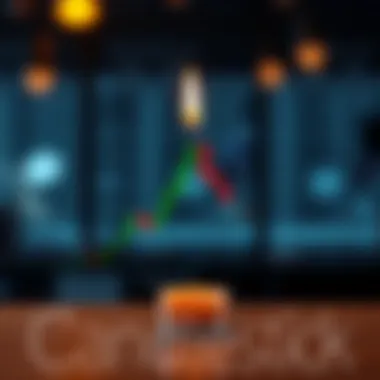Mastering Candlestick Patterns: A Guide for Beginners


Intro
In the ever-changing world of trading, candlestick charts have established themselves as a crucial tool for many traders, particularly for those navigating the cryptocurrency space. These graphical representations of price movements do more than just present numbers; they encapsulate market psychology and sentiment. For novices, understanding how to read these candlesticks can feel like trying to decipher a complex code. Here, we unpack the core elements of candlestick analysis while emphasizing the importance of context and market trends.
A candlestick itself consists of a body and wicks, which offer insights into the price range over a specific period—be it minutes, hours, or days. Instead of treating each candlestick in isolation, it’s essential to appreciate their role within broader market narratives.
What lies beneath the surface of each candlestick can reveal the attitudes and behaviors of traders, presenting a richer story than pure numerical data ever could. As we move through this guide, we will break down the structure of these candles, explore common patterns, and discuss their practical applications. Along the way, we will also touch upon the significance of market trends and other nuances affecting price fluctuations, primarily aiming to demystify the process for those just starting out on their trading journey.
Prologue to Candlestick Analysis
Understanding candlestick analysis is a cornerstone for anyone venturing into trading, particularly in an era where market sentiments fluctuate like the wind. The ability to read these visual cues equips traders with the insights needed to navigate the complex terrain of buying and selling. Through this section, you'll discover the significance of candlestick patterns, which serve not just as indicators, but as storytelling devices that reveal the emotions behind price movements.
Candlestick charts provide a unique snapshot of market activity, capturing the open, high, low, and close prices over a defined time frame. This multifaceted view allows traders to see not only where the prices have been, but also to gauge the momentum and potential future movement. By delving into candlestick analysis, novice traders gain a language to interpret market psychology, enhancing their decision-making process.
Key Elements and Benefits
- Simplicity in Visualization: Candlesticks are more than a bunch of lines; they illustrate price action in a format that's easier to interpret than traditional bar charts. Each candlestick tells a story—its coloration, shape, and position convey a wealth of information at a glance.
- Market Sentiment Reflection: Traders are not just buying and selling; they are reacting to events, news, and other influences. Candlesticks encapsulate this sentiment succinctly, showing bullish (upward) or bearish (downward) pressure through their formation.
- Predictive Power: While no analysis method is foolproof, certain patterns can provide indicators of future price movements, making it a valuable tool for informed trading strategies.
- Versatility: Candlestick analysis can be utilized across various markets—stocks, forex, and even cryptocurrencies—allowing traders to apply their knowledge consistently regardless of the asset class.
With so many advantages, getting a grip on candlestick analysis could very well define your trading prowess. Let's peel back the layers and explore what candlesticks are.
What Are Candlesticks?
At their core, candlesticks are graphical representations of price movements over a specified time. Imagine a candle: the body represents the distance between the open and close prices, up or down, while the wicks (or shadows) depict the extremes of price during that period. If the close is higher than the open, the body is typically colored green or white, indicating a bullish sentiment. Conversely, if the close is lower than the open, it turns red or black, signaling bearish behavior.
In essence, these formations help traders visualize the dynamics between buyers and sellers. The body might appear thick or thin based on price action, and the wick can stretch high or low, reflecting volatility. It becomes an intricate tapestry of collective market psychology.
The Origin of Candlestick Charts
The practice of using candlestick charts dates back to the 18th century in Japan, where rice traders utilized these techniques to analyze prices and predict market trends. Munehisa Homma, a renowned rice trader from Sakata, is often credited as the pivotal figure in the development of candlestick charting. His observations provided insight not only into prices but also the emotional states of market participants.
Candlestick charting eventually permeated through the trading world, particularly into the Western financial markets in the latter part of the 20th century. The adaptiveness of this form of analysis made it highly relevant as financial markets evolved with time, incorporating new technologies and trading strategies.
By understanding its origins, you begin to appreciate the historical context and the evolution of the candlestick as a tool for traders. What started out as a method for rice traders has transformed into a sophisticated approach embraced by today's investors in diverse markets.
Understanding Candlestick Structure
Understanding the structure of candlesticks is a pivotal component for anyone looking to improve their trading prowess. This foundation is crucial, as it allows traders to decode market movements and gauge investor sentiment. When you grasp how a candlestick is formed and what each part represents, you will not only deepen your analytical abilities but also enhance your decision-making processes in trading.
One of the primary benefits of mastering candlestick structures is the ability to read market psychology effectively. Each candle gives a snapshot of price action within a specific timeframe and can reflect the struggle between buyers and sellers. Ignoring this aspect could lead to missed opportunities or, worse, poor investment choices.
In this section, we'll explore the core components of a candlestick and dive into their meanings. Understanding these elements transforms the way you interpret charts, providing a more nuanced perspective on price dynamics.
Components of a Candlestick
A candlestick chart consists of several critical components that each tell a part of the story. These elements include the body, the wick, and sometimes the shadows. Breaking them down helps demystify the breadth of information contained within a single candle.
- Body: This is the thick part of the candlestick and represents the range between the opening and closing prices for that period. If the close is higher than the open, it’s typically colored green or white, indicating a bullish sentiment. Conversely, if the close is lower, the body may appear red or black, signifying bearish pressure.
- Wick: The wick, or tail, extends above and below the body and signifies the day's price extremes (the highest and lowest prices). A long wick can indicate rejection of price levels, while a short wick suggests consolidation.
- Shadows: Shadows refer to the parts of the candlestick that extend beyond the body. The upper shadow signifies the highest price during the time period, while the lower shadow reflects the lowest price reached. The relationship between these elements can offer insights into market volatility.
"A single candle can reveal the market's mood at a glance; understanding it is like holding a key to a secret door."
Body, Wick, and Shadows Explained
Now, let’s delve a bit deeper into the specifics of the body, wick, and shadows. Each component plays a different role in conveying vital information about price action.
1. The Body
- The body size can indicate the strength of the market movement. A long body suggests strong buying or selling pressure, while a shorter body might suggest indecision. For example, a large green body on a daily chart indicates robust buying, hinting at potential continuation in the uptrend.
2. The Wick


- The length of the wick tells traders about price rejection. A long upper wick implies sellers stepped in after a rally, while a long lower wick suggests buyers defended a price level during a downturn. These nuances tell traders whether the market might reverse or continue its current trend.
3. The Shadows
- Shadows can further clarify the overall sentiment. In periods of heightened volatility, you may observe candlesticks with lengthy shadows, representing erratic price movements. These shadows are instructive; they hint at underlying uncertainty in the market, which traders must approach with caution.
By understanding these elements, traders can interpret patterns and trends with significantly more clarity. This knowledge forms the groundwork for analyzing more complex strategies and patterns explored in later sections of this guide. In sum, studying candlestick structure equips beginners with the analytical tools required to navigate the trading labyrinth, paving the way for informed decisions and successful trading strategies.
For more detailed insights into candlestick patterns, check out resources from Investopedia and Wikipedia.
Embrace the learning process; it may take time, but the proficiency you gain will be invaluable.
Types of Candlestick Patterns
Understanding candlestick patterns is like learning a new language in the world of trading. These patterns are visual representations of price movements, and they offer invaluable insights into market sentiment. In this segment, we will uncover the nuances of both single and multiple candlestick patterns, highlighting their unique traits and the specific roles they play in shaping trading strategies.
Single Candlestick Patterns
Doji
The Doji is often deemed one of the most significant single candlestick patterns due to its ability to indicate indecision in the market. Characterized by a very small body where open and close prices are nearly identical, the Doji suggests that buyers and sellers are in a standstill. Its importance lies in its simplicity; when observed at critical support or resistance levels, it can signify a potential reversal.
What sets the Doji apart is its flexibility; it can emerge in various market conditions. However, a Doji is more powerful when it forms after a sustained trend. A bullish Doji at the bottom of a downtrend can suggest a potential upward reversal, while a bearish Doji at the top of an uptrend hints at a possible downturn.
Though it presents advantages, the Doji is not without its pitfalls. The ambiguity it embodies can lead traders to second-guess their decisions, especially with false signals arising in choppy markets.
Hammer
The Hammer candlestick is a warrior of the charts, representing resilience and the potential for a trend reversal. This pattern forms when the price falls sharply during the session but rebounds to close near the opening price. The hallmark feature of a Hammer is its long lower wick, while the body remains relatively small at the top.
Hammer candlesticks are typically spotted in a downtrend, signaling that buyers are stepping in to support prices. Its key characteristic, the pronounced lower shadow, illustrates how bulls can regain strength after weakness. This ability to signal potential price rebounds makes the Hammer a favored choice for many traders.
Still, the advantages of the Hammer come wrapped in caution. For optimal use, traders should look for additional confirmation, such as higher trading volume or subsequent bullish candles, to validate the signal.
Shooting Star
Then, we have the Shooting Star, a pattern that’s as ominous as it sounds. The Shooting Star emerges after a rally and is characterized by a small body at the lower end of the price range, with a long upper wick extending dramatically upward. This formation delivers a clear message—sellers are stepping in after buyers have driven prices up, suggesting that a reversal to the downside might be imminent.
The key trait of the Shooting Star is its position after an uptrend, serving as a warning to traders that the market may soon reverse direction. It is particularly potent when accompanied by increased trading volume and a confirmation candle confirming the drop.
However, it’s important to keep in mind that not every Shooting Star guarantees a price decline. Like many patterns, its effectiveness can be dilated by the overall market context, thus making it essential to analyze other variables before acting on it.
Multiple Candlestick Patterns
Engulfing Patterns
Engulfing Patterns are where the drama unfolds. This pattern consists of two candles, with the second candle completely engulfing the body of the first one. They can appear either bullish or bearish, depending on the direction. In bullish engulfing, a small bearish candle is followed by a larger bullish one, signaling that buyers are taking control. The bearish engulfing pattern, on the other hand, features a bearish candle engulfing a preceding bullish candle, indicating a shift towards selling.
The essence of Engulfing Patterns is their capacity to provide clear trade signals based on market momentum. Their distinct characteristic of one candle completely overpowering the other makes them attention-grabbing and easier for traders to act upon. However, relying solely on this signal can lead to pitfalls, especially in volatile markets, where false signals might be lurking.
Morning Star
The Morning Star is often celebrated for its portrayal of hope after a downtrend. This three-candle pattern consists of a bearish candle, followed by a smaller one (the star), which is then followed by a strong bullish candle. The Morning Star symbolizes a potential reversal, suggesting that bulls might be taking charge.
Its walloping power is birthed from its formation amidst a clear downtrend. Traders are drawn to the Morning Star as it provides a cohesive narrative of buyer strength gradually overcoming sellers. However, as with other patterns, traders should watch for confirmations in volume or trend strength to validate their directions.
Evening Star
Conversely, the Evening Star takes the stage, reflecting potential downfall when least expected. This pattern is akin to its morning twin but appears at the peak of an uptrend. It features a bullish candle, a smaller star, and a bearish candle that engulfs the previous two. The signature of this pattern lies in its ability to signal that the forces of selling are gaining strength.


For many traders, recognizing the Evening Star can mean the difference between riding a wave downwards or avoiding a costly mistake. Yet, as always, the underlying market context is pivotal; a lone Evening Star in a bullish market may not bear much weight without supporting evidence from volume or other indicators.
Interpreting Candlestick Patterns
Understanding how to interpret candlestick patterns is quite essential for any trader, especially novices stepping into the bustling world of trading. Candlesticks tell stories about price movement, offering insights into market psychology. Learning to read these patterns effectively can present a significant advantage. Traders can make more informed decisions, identify trends early, and respond to price actions appropriately. All of this culminates in better trading outcomes.
Market Sentiment and Candlestick Patterns
Market sentiment refers to the overall attitude of investors towards a particular security or the market as a whole. Candlestick patterns reflect this sentiment visually. For instance, a series of green candles could suggest bullish sentiment, indicating buyers are in control. Conversely, if the market is filled with red candles, sellers might be driving prices down. Understanding this can help traders gauge whether to buy, sell, or hold their assets.
Consider the Doji candlestick: it often signifies indecision in the market, indicating that buyers and sellers are about equal in strength. A trader spotting a Doji would benefit from paying closer attention; the following candle could reveal which direction the sentiment may lean.
Additionally, news events can shift market sentiment quickly, making it crucial for traders to consider external factors along with candlestick patterns to make well-rounded decisions. For example, if a powerful economic report is released after a bullish engulfing pattern, it might strengthen the bullish sentiment, leading traders to take upward positions.
"Candlestick patterns are like clues whispered by the market; piecing them together can reveal the bigger picture."
Contextual Analysis of Patterns
Context is the name of the game when interpreting candlestick patterns. A single candlestick might have different meanings depending on its place in the overall trend and market behavior. For example, a Shooting Star appearing after an extended bullish run could be ominous, indicating a potential reversal. Here, it’s the context—the preceding bullish trend—that provides critical information about the validity of the pattern.
Analyzing candlestick patterns in isolation can lead to misleading conclusions. This is why it’s vital to examine them in the context of support and resistance levels, trendlines, and ongoing economic indicators.
When considering a Morning Star pattern—a three-candle formation—its effectiveness becomes apparent only with a backdrop of downtrends or at significant support levels. Recognizing these subtleties can provide a fuller understanding of what the market is doing and why.
In summary, always remember that interpreting candlestick patterns correctly hinges on both market sentiment and the context in which patterns appear. With diligence and practice, a trader can sharpen their skills in reading these patterns, ultimately leading to smarter trading decisions.
For those looking to explore further, resources such as Investopedia and BabyPips can offer further insights into market psychology and candlestick analysis.
Using Candlesticks for Trading Decisions
When it comes to trading in financial markets, the ability to read and interpret price movements is paramount. Candlestick charts offer a unique visual representation of market sentiment that can be invaluable for traders. The art of using candlesticks for trading decisions isn't just about understanding patterns; it’s about grasping the story behind each candle. By analyzing candlestick formations and their implications, traders can set themselves up for better decision-making.
The importance of using candlesticks for trading decisions lies in their ability to capture the ebb and flow of market emotion. Unlike traditional bar charts, candlesticks provide a clearer picture of price action, enabling traders to spot potential reversals or continuations. This visual clarity removes much of the guesswork involved in trading, allowing for more strategic entry and exit points.
Setting Entry and Exit Points
Establishing clear entry and exit points is a foundational aspect of any trading strategy, and candlesticks shine in this area. A well-placed entry point can mean the difference between profit and loss. Traders often look for specific candlestick patterns that signal optimal times to enter a trade, such as a 'hammer' or a 'bullish engulfing pattern'. These formations often indicate a shift in momentum, suggesting that it could be the right time to place a buy order.
Similarly, exit points are crucial for securing profits and cutting losses. By analyzing candlestick patterns near key support and resistance levels, traders can identify when it might be wise to exit a position. For instance, a 'shooting star' pattern on a bullish trend could signal a possible reversal, indicating it's time to cash out before the tide turns. Here are some tips for setting effective entry and exit points:
- Use Support and Resistance Levels: Major support and resistance levels highlighted by previous price action can help in deciding on entries and exits.
- Watch for Reversal Patterns: Be on the lookout for clear reversal signals in candle formations. These can often guide decision-making.
- Combine with Other Indicators: Integrating candlestick analysis with indicators like Moving Averages can provide a more holistic view of the market.
Risk Management Strategies
No strategy is complete without addressing risk management, and candlestick analysis plays a significant role in minimizing potential losses. Even with a seemingly foolproof setup, unforeseen market movements can occur, making proper risk management crucial to longevity in trading. Understanding how to read candlesticks can equip traders with tools to implement robust risk management strategies.
One common tactic is to define stop-loss levels based on candlestick formations. For example, placing a stop-loss order just below the low of a 'bullish engulfing' candle can protect against unfavorable market movements that may occur if the trade doesn't go as planned. Here are some effective risk management strategies:
- Position Sizing: Determine how much capital to risk per trade, usually a small percentage of the total account balance, ensuring that no single trade can drastically affect overall portfolio health.
- Trailing Stops: As the trade moves in the trader’s favor, using trailing stops can help secure profits while allowing for further gains.
- Setting Ratio Targets: Aim for a risk-reward ratio that justifies the risk being taken. A common benchmark is 2:1, meaning the potential reward should be double that of the risk.
"Proper risk management is not just a strategy; it’s a discipline that separates successful traders from the rest."
By leveraging the insights gained from candlestick analysis, traders not only enhance their decision-making prowess but also build a solid foundation for managing risks effectively. This balanced approach can lead to sustained success in the complex world of trading.
Combining Candlestick Analysis with Other Tools
Integrating candlestick analysis with other analytical techniques enhances the understanding of market trends and prepares traders to make more informed decisions. Candlestick charts provide a visual representation of price movements, but they can be more powerful when used in conjunction with technical indicators and fundamental analysis. This multifaceted approach can lead to improved predictions and better risk management.
Technical Indicators and Candlesticks


Moving Averages
Moving Averages are widely used to smooth out price data over a specific time period, which helps in identifying the trend direction. The beauty of Moving Averages lies in their simplicity; they boil down the data into an easily interpretable form. For example, if you're looking at a 50-day Moving Average, it can clearly show whether the market is trending upwards or downwards based on the average of the last 50 days.
One characteristic that makes Moving Averages especially appealing is their ability to act as dynamic support and resistance. When the price is above the Moving Average, it may indicate a bullish trend, while prices below can indicate bearish sentiment. However, one should be cautious as they lag behind the price movements and don't always predict reversals accurately due to their reactive nature.
RSI
The Relative Strength Index, or RSI, is a momentum oscillator that measures the speed and change of price movements. It’s a handy tool for gauging whether a market is overbought or oversold, operating on a scale from 0 to 100. Generally, an RSI above 70 suggests an asset may be overbought, while an RSI below 30 indicates it may be oversold.
What sets RSI apart is its focus on momentum rather than just price. This feature allows traders to spot potential reversals before they occur, making it a popular choice among market analysts. However, since it can sometimes give false signals, it's advisable to combine it with candlestick patterns for confirmation of your trading decisions.
MACD
The Moving Average Convergence Divergence (MACD) is another technical indicator that many traders rely on. It shows the relationship between two moving averages of a security's price. The MACD can help identify potential buy and sell signals based on the convergence and divergence of these averages. Traders often use it along with the zero line crossings to pinpoint moments when momentum is shifting.
A key characteristic of MACD is its ability to illustrate the trend's strength. It can confirm what the candlestick patterns are suggesting, providing an extra layer of insight. However, like other indicators, MACD can lag in volatile market conditions, sometimes leading you down the wrong path if only used in isolation.
Integrating Fundamental Analysis
Fundamental analysis takes a different angle by examining the underlying factors that affect an asset's value, like economic indicators, financial statements, or geopolitical events. While candlestick analysis focuses on price action, incorporating fundamental data helps understand why prices react in a certain manner.
For instance, knowing that a major economic report is set to be released can help traders anticipate volatility that might not be visible on a candlestick chart. This can be crucial information when trading around news events, as market responses can be immediate and dramatic. By combining candlestick patterns with an understanding of fundamental events, traders can better navigate the complexities of the market.
Integrating various analytical approaches—such as candlestick patterns, technical indicators, and fundamental analysis—can provide a comprehensive view of the market, enhancing decision-making.
Practical Tips for Beginners
Delving into candlestick analysis can feel like trying to solve a puzzle in a dimly lit room. The methods might seem intricate at first glance, but practical tips can light the path. Having the right tips not only sharpens one’s skills but also solidifies the understanding of candlestick patterns, enabling more informed trading decisions. Knowing what to do—and what not to do—can simplify the learning process and enhance effectiveness in the trading arena.
Common Mistakes to Avoid
In the world of candlestick analysis, newbies often stumble over the same errors, which can lead to missed opportunities or worse—losses. Here are some recurring pitfalls to sidestep:
- Ignoring Context: Too often, traders dive into patterns without proper context. A bearish engulfing pattern in a bull market might not signal a flip to the downside as strongly as it would in a bear market.
- Over-Reliance on Individual Patterns: No single candlestick or pattern can dictate market direction. Relying solely on one aspect can distort your view. Always consider candlestick patterns in conjunction with other tools or indicators.
- Neglecting Risk Management: New traders can get carried away with excitement and overlook risk management. Set aside a clearly defined risk percentage for each trade, ensuring you protect your capital.
- Emotional Trading: Emotional decisions can cloud judgment. Fear and greed often lead to poor trading choices, like chasing losses or exiting before a pattern fully develops. Stick to your strategy and assess market movements rationally.
- Failure to Practice: Jumping into real trades without practicing first can be disastrous. Utilize demo accounts to practice reading candlesticks as they present real-time market data without the financial risk.
By steering clear of these common mistakes, traders can set themselves up for a better learning experience and a higher chance of success.
Resources for Further Learning
For those driven to deepen their understanding of candlestick patterns and trading strategies, a wealth of resources exists. Here’s a shortlist that could be invaluable:
- Books: "Japanese Candlestick Charting Techniques" by Steve Nison is considered a classic. It dives deep into the history and methodology, making it suitable for both beginners and seasoned traders.
- Online Courses: Websites like Coursera and Udemy offer structured courses on technical analysis and candlestick training that cater to various skill levels.
- Webinars and Workshops: Look for upcoming webinars hosted by experienced traders or trading schools. Real-time discussions can provide insight beyond the text.
- Communities: Engaging in platforms like Reddit’s r/Daytrading or TradingView can facilitate discussions with other traders. Sharing insights and experiences can hasten the learning curve.
“The market does not know you. It has its rhythm. Listen, don’t force your will.”
— An adage worth embracing.
- YouTube Channels: Channels focused on trading, such as Rayner Teo’s or Warrior Trading, offer free content that breaks down candlestick patterns visually.
By immersing yourself in these resources, you'll gain further knowledge that can refine your understanding and application of candlestick analysis.
Ultimately, the journey into candlestick analysis is one of ongoing learning and growth. Avoiding common blunders while utilizing the wealth of resources available can empower you as a trader. Embrace continuous education, and you’ll find yourself navigating the trading landscape with more confidence.
Finale
In wrapping up our journey through the intricate world of candlestick analysis, it’s essential to underscore the significance of the insights gleaned. This article has delved into various aspects of candlesticks, spotlighting their role in understanding market dynamics. For newcomers, grasping these complex patterns can feel like deciphering a foreign language; however, the knowledge gained here is invaluable for anyone stepping into trading environments, particularly in crypto, where market movements can be as swift as they are unpredictable.
The thorough overview of individual components, patterns, and their implications provides a solid foundation for further exploration. As we’ve discussed, different candlestick formations can signal shifts in market sentiment and provide crucial hints about potential price movements. It’s not just about numbers and charts; it’s about reading the story that the market is telling through these figures. By acknowledging the importance of context, traders can better align their strategies to meet the market where it is.
A few key takeaways include:
- Recognizing basic candlestick structures enables better analysis of market sentiment.
- Different patterns should be contextualized rather than interpreted in isolation; understanding the surrounding price action adds depth to your analysis.
- Risk management remains paramount; using candlestick patterns as a part of a larger strategy is the way to go.
Ultimately, the benefit of mastering candlestick analysis lies in enhancing your decision-making capabilities, allowing for more informed choices that can lead to greater confidence and potentially increased success in your trading endeavors. The more you practice and observe these patterns, the more intuitive this skill becomes.
"Trading is not just about winning or losing; it's about managing losses and letting your profits run."
This reiterates the critical balance between analyzing candlestick patterns and incorporating a comprehensive trading strategy.



